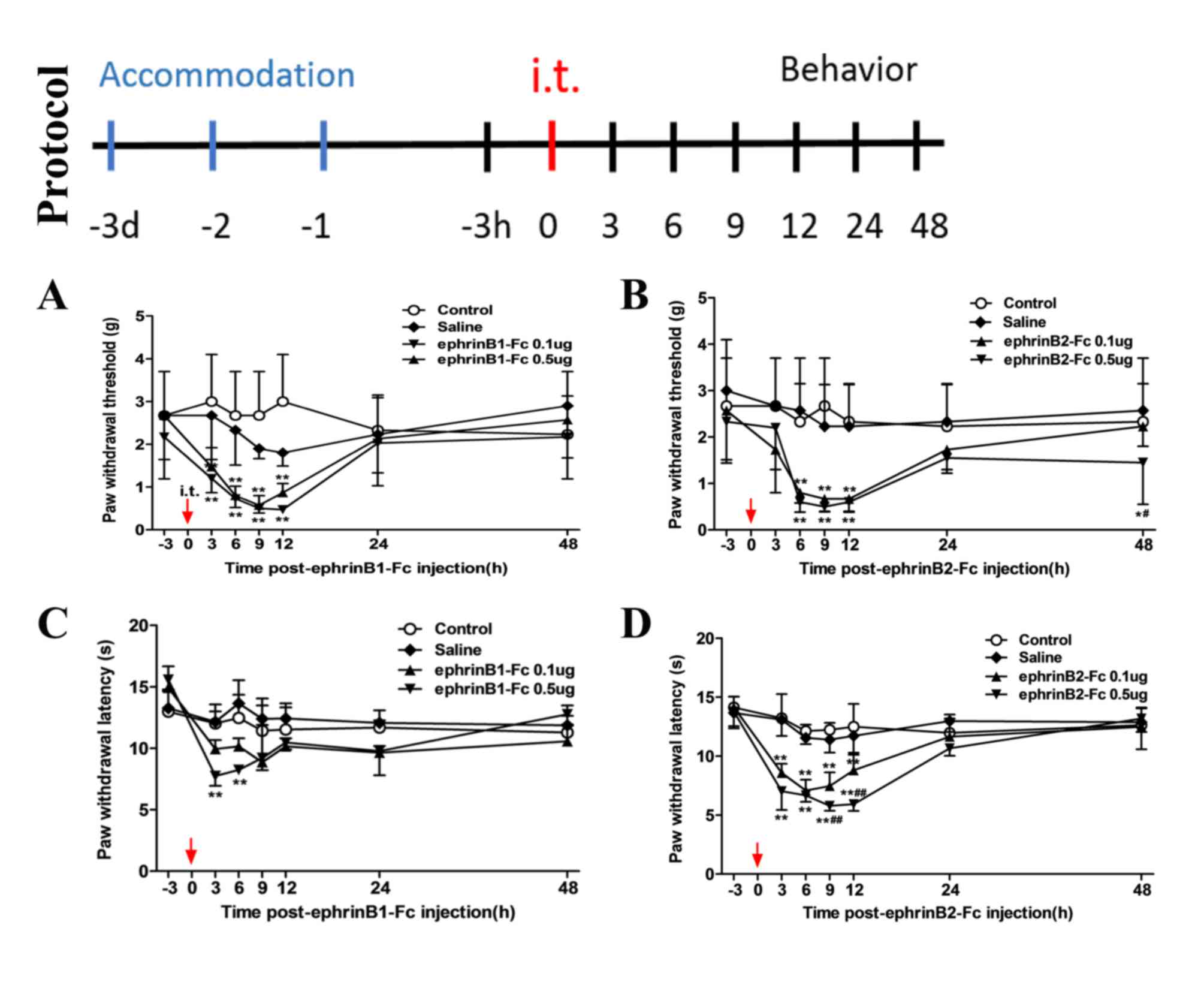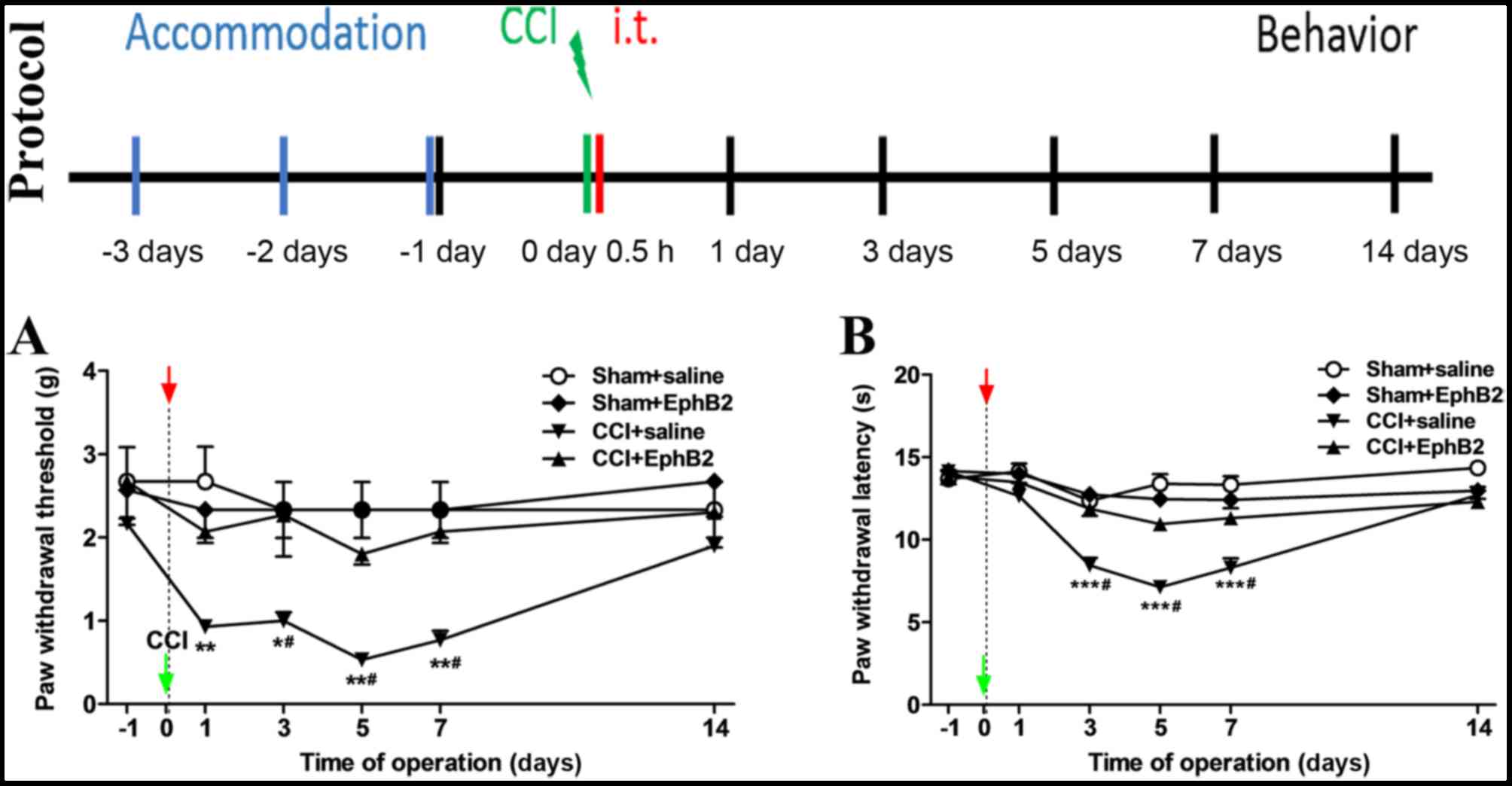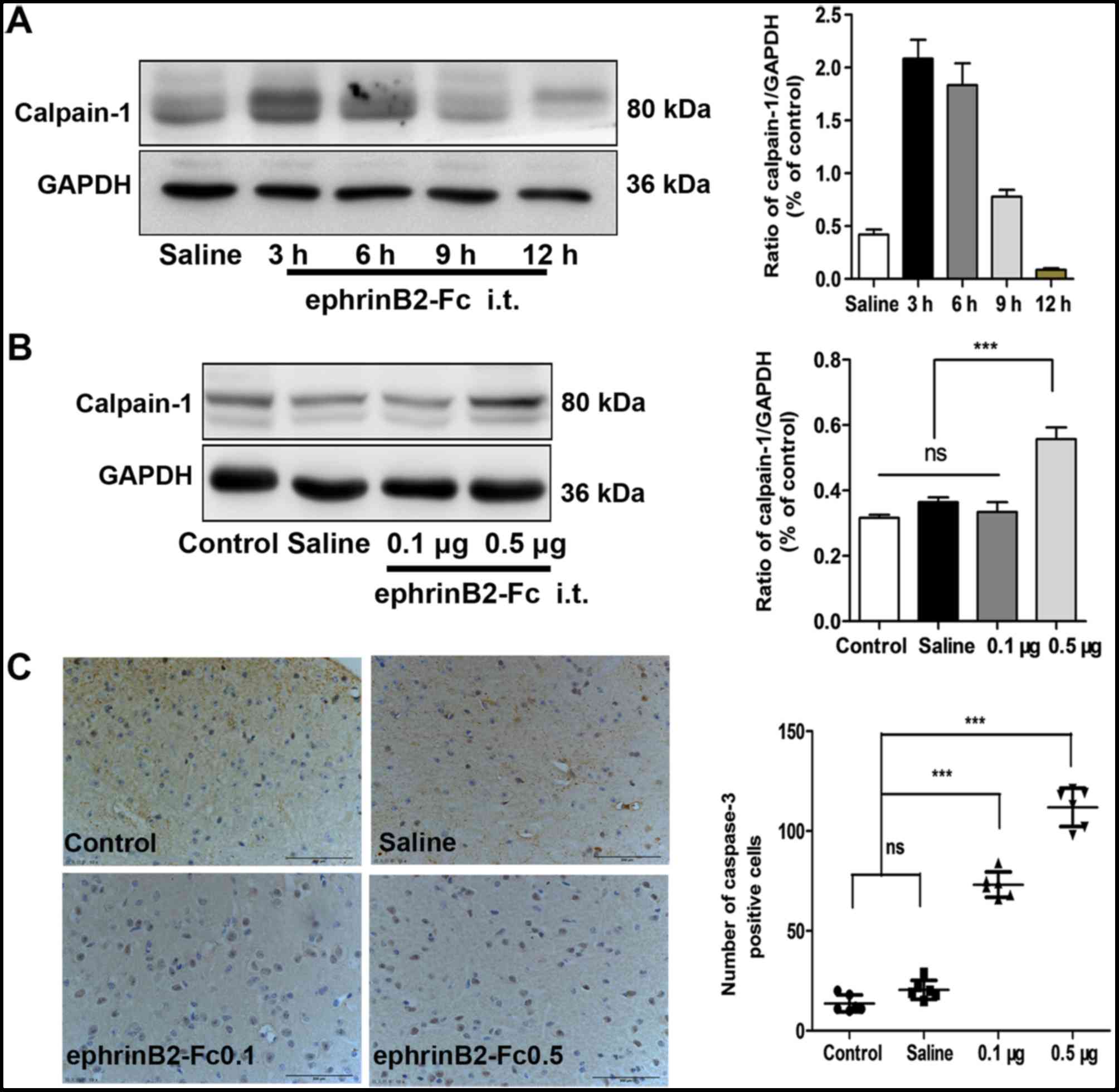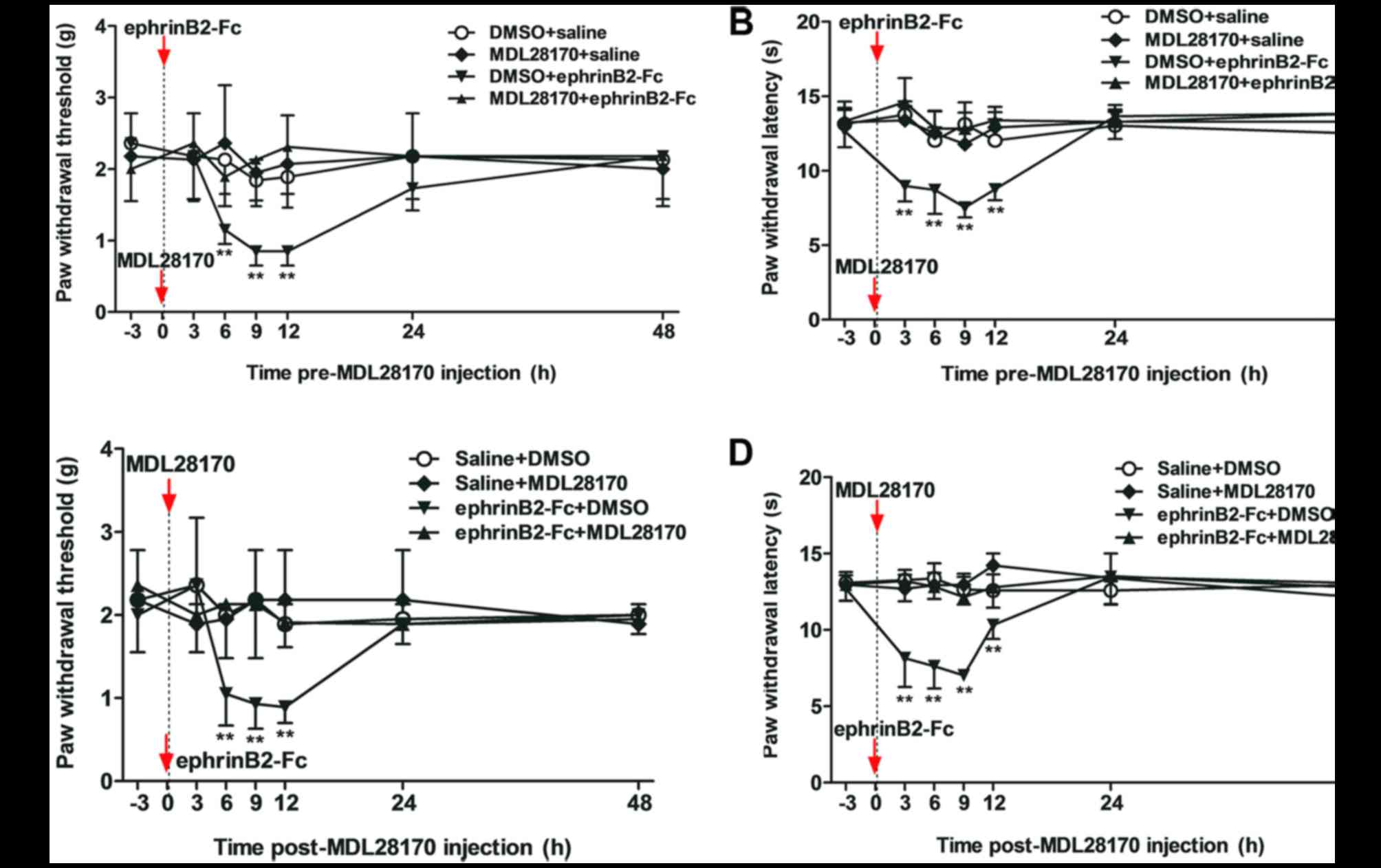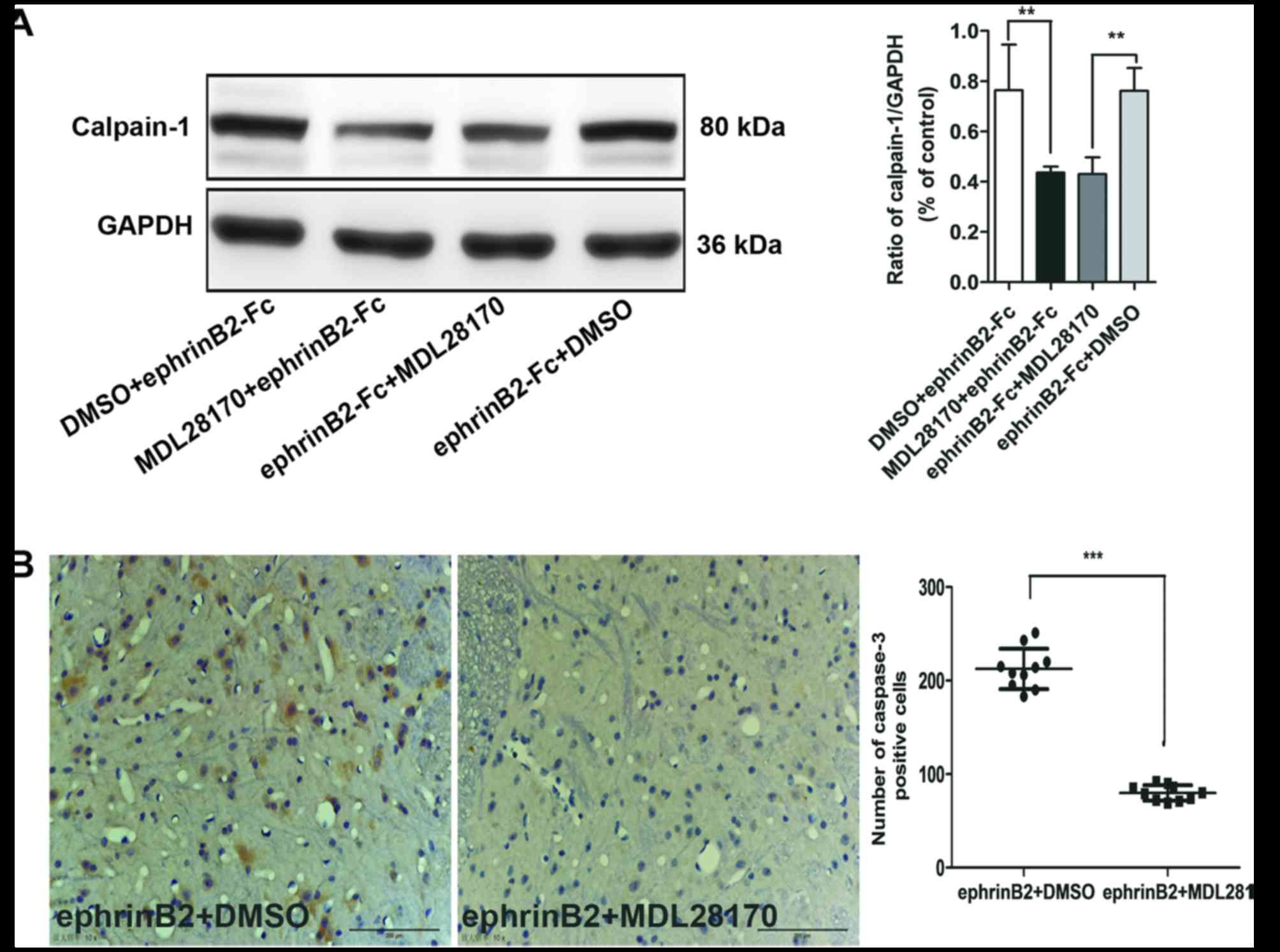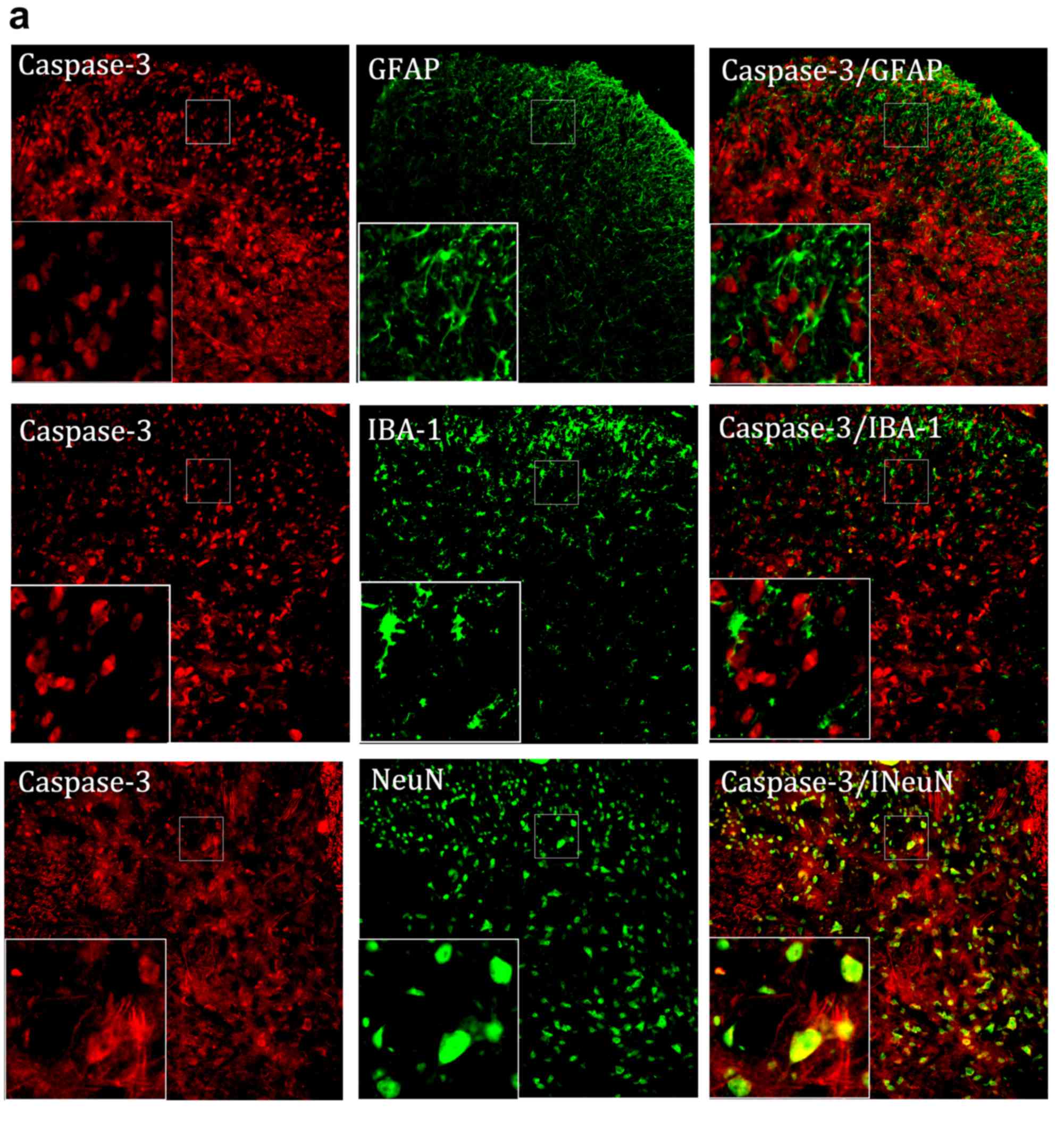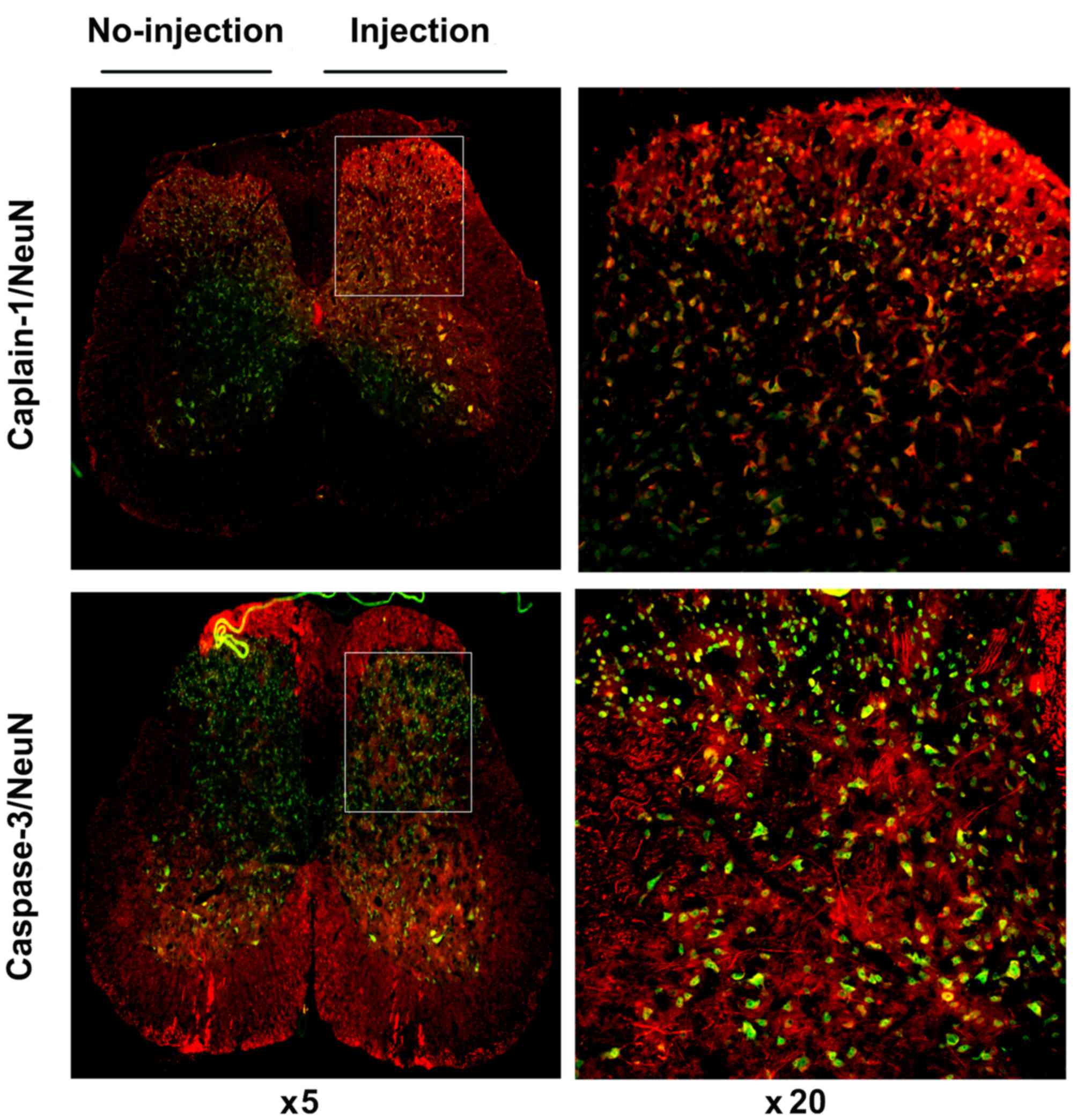EphrinB/EphB signaling contributes to spinal nociceptive processing via calpain‑1 and caspase‑3
- Authors:
- Published online on: May 9, 2018 https://doi.org/10.3892/mmr.2018.8996
- Pages: 268-278
-
Copyright: © Yang et al. This is an open access article distributed under the terms of Creative Commons Attribution License.
Abstract
Introduction
Spinal nociceptive pain continues to be a serious clinical challenge. Despite having been evaluated in numerous studies, the underlying cellular and molecular mechanisms that control the induction and maintenance of spinal nociceptive pain remain to be fully elucidated (1,2). These mechanisms are reported to involve a combination of neural excitability and spinal synaptic plasticity, with unique characteristics (3,4). In addition, nerve injury elicits neuronal alterations, including the promotion of synapse formation during the development of pain (5). The spinal cord is the main center of pain information transmission and integration. The central sensitization of spinal dorsal horn neurons is involved in the primary mechanism of spinal nociceptive pain, which is mainly manifested in the long-term potentiation (LTP) effect of synaptic transmission. LTP is one of two important forms of synaptic plasticity, and its role in pain is mainly achieved by synaptic morphological plasticity and functional plasticity. A previous study found that the synaptic membrane area, the post synaptic density, the number of synaptic vesicles, the synaptic gap, and the density of total synapses were increased significantly in rats suffering from neuropathic pain (6). In addition, γ-aminobutyric acid and glutamate receptors are involved in the regulation of spinal nociceptive pain as essential inhibitory and excitatory receptors, respectively, in synapses (7).
Several studies have shown that signal transduction have important in the development and progression of spinal nociceptive pain. Currently, the majority of investigations have focused on the role of signal transduction via receptor tyrosine kinases (RTKs). EphrinB and EphB receptors are the most important subfamily of RTKs in humans. Their activation depends on the close proximity (or adhesion) of cells, allowing the ligand to bind to the receptor and activate signal transduction. They are involved in numerous vital developmental processes and in the maintenance of pain by regulating revascularization, cell migration, axon guidance and synaptic plasticity (8,9). In addition, ephrinB/EphB are important in physical changes in the brain and peripheral tissues. Eph family members are numerous, and according to their sequence homology, distribution, and mutual affinity with the ligand, they are divided into two partially overlapping families, A and B. There are 10 EphA receptors (EphA1-EphA10), six EphB receptors (EphB1-EphB6) and three ephrinB ligands (ephrinB1-ephrinB3). Ephrin is a transmembrane protein with a transmembrane domain and a cytoplasmic domain. The cytoplasmic domain is highly conserved and contains five potential tyrosine phosphorylation sites, whereas the carboxy terminus forms a PDZ (discoid homology region) domain-binding motif. Eph receptors are also transmembrane proteins with extracellular (containing ligand-binding domains), transmembrane and intracellular domains, a cysteine-rich structure and two fibronectin repeats. The intracellular region has two membrane-proximal tyrosine residues, comprising the classical protein tyrosine kinase binding domain, the sterile α-motif domain, and the PDZ binding domain. Ephrin-A ligands typically bind specifically to the EphA receptor, and Ephrin-B ligands bind specifically to the EphB receptor; however, the EphA4 receptor has a ligand-binding domain with a broader specificity, which binds to the majority of ephrin-A, ephrin-B2 and ephrin-B3 ligands. EphrinB/EphB can regulate the activity of post-synaptic N-methyl-D-aspartate (NMDA) receptors by regulating the release of L/D-serine from astrocytes and regulating synaptic plasticity via glutamine-glutamate cycling. In addition, ephrinB/EphB can induce central sensitization and is involved in nociceptive information modulation by activating the downstream mitogen-activated protein kinase pathway and the Src family kinase (10).
In addition to tryosine protein kinase (TPK)-dependent signal transduction, calpains are activated during the sensitization of nociceptive neurons through synaptic plasticity (11). Calpain-1, which belongs to the cysteine protease enzyme family, is a calcium-activated neutral protease. Central nervous system injury or disease can increase intracellular Ca2+ concentrations, leading to excessive activation of calpains and scaffold proteins, membrane protein degradation (12), mitochondrial permeability changes, or phosphorylation of calpastatin and calpain and other unknown pathways mediating central cell death or apoptosis (13,14). Differences have been observed in the time and location of calpain-1 following its activation; a cleaved caspase-3 protein fragment activated by calpain-1 and caspase-3 increased the activity of calpains in turn (15,16). A preliminary experiment showed that numerous caspases and calpains are present in pre- and post-synaptic compartments of neurons, and are important in modulating synaptic plasticity (17). From the information mentioned above, it is clear that the ephrinB/EphB signaling pathway is vital in the development of nociceptive pain by regulating synaptic plasticity, and that the pathway formed by calpain-1 and caspase-3 also regulates synaptic plasticity and neural circuitry. However, whether the pathway formed by calpain-1 and caspase-3 is involved in processing ephrinB/EphB signaling pathway-induced nociceptive pain remains to be fully elucidated. Therefore, it was hypothesized in the present study that ephrinB/EphB signaling is involved in the processing of nociceptive pain via the actions of calpain-1 and caspase-3.
Materials and methods
Animals
All experiments involved adult male Kunming mice (22–25 g) and were approved by the Animal Experimental Center, Second Military Medical University (Shanghai, China; production license no. SCXK (hu)2012-0003). The mice were supplied by the Institutional Animal Care and Use Committees and handled in accordance with the regulations of the Ethics Committee of the International Association for the Study of Pain (https://www.iasp-pain.org) and experimental methods. The mice were housed in individual cages in a temperature-controlled (18–28°C) room with alternating 12-h light/dark cycles. Food was withheld for 8 h prior the start of the experiments, and all animals had free access to water. Monitoring of health problems was performed three times each day and no deaths occurred during the experiments.
Surgical procedures
Drug injection model
A total of 164 mice were used in the experiments; 64 mice were injected with either ephrinB1-Fc or ephrinB2-Fc (0.1 and 0.5 µg). The saline injection group was used as a comparison group with the ephrinB injection groups to indicate the effect of ephrinB injection; the blank control group (control group) was used to verify that intrathecal injection of saline alone had no effect on the mice. A total of 72 mice were injected with MDL28170 (an inhibitor of calpain-1), and with the respective solvent as a control, with saline and ephrinB as a control, and dimethyl sulfoxide (DMSO) and MDL28170 as a control The method of injection was as described by Hylden and Wilcox (18). Briefly, 10-µl trace syringes were used and inserted vertically between the L5 and L6 vertebrae of the experimental mice. If the tail of the mice exhibited a sudden slight swing, entry into the subarachnoid space had occurred. The volume of drug or contrast solvent was 5 µl, which were injected into the subarachnoid space over a 20 sec period, and the trace syringes were held in place for 10 sec, the total duration being 30 sec.
Chronic constrictive injury (CCI) model
Of the 164 mice as described above, 28 mice were used to establish the CCI model. The main protocol was described by Bennett and Xie (19). Briefly, the mice were deeply anesthetized using sodium pentobarbital (45 mg/kg, intraperitoneally). The left sciatic nerve was exposed at the mid-thigh and a 4-0 silk thread was used to ligate it loosely in four regions at ~1-mm intervals. For the mice in the sham group, the nerve was exposed but no ligation or damage was induced.
Drugs
The ephrinB1-Fc (cat. no. 80106-R02H) chimera (EphB receptor activator), and EphB2-Fc (cat. no. 51367-M02H) chimera (EphB receptor-blocking reagent), were purchased from Sino Biological, Inc. (Beijing, China). The ephrinB2-Fc chimera was purchased from R&D Systems, Inc. (Minneapolis, MN, USA). Anti-calpain-1 antibody (cat. no. ab28258) was purchased from Abcam (Cambridge, UK). The caspase-3 rabbit monoclonal antibody was purchased from Cell Signaling Technology, Inc. (Danvers, MA, USA). The calpain- and cathepsin B-selective inhibitor, MDL28170, was purchased from Cene Operation (Ann Arbor, MI, USA). Each drug was dissolved in normal saline (NS); the dose and the time of treatment were based on the results of preliminary experiments.
Behavioral assessment
The measurement of mechanical allodynia was represented by the mechanical withdrawal threshold (MWT). The MWT was assessed using von Frey hairs according to the up-and-down method described by Chaplan et al (20). Briefly, the mice were placed in individual plastic boxes (20×20×15 cm) on a metal mesh floor and allowed to acclimate for ~1 h prior to assessment. Beginning with 0.16 g and ending with 4.0 g, the von Frey filament was used to touch the plantar surface of the hind paw, which was held for 6–8 sec. In the event of the absence of paw withdrawal, the next higher stimulus was selected, whereas a weaker stimulus was applied in the opposite situation. This was repeated 10 times and the stimulation strength was determined as the average corresponding to a 50% response rate.
The measurement of thermal hyperalgesia was determined by the thermal withdrawal latency (TWL). The TWL was assessed as described by Hargreaves et al (21). Briefly, the mice were placed in individual plastic boxes (7×9×11 cm) on a temperature-controlled glass floor and allowed to acclimate for 1 h prior to assessment. The radiant heat source was focused on a region of the hind paw and was moved away immediately when the mice lifted up or licked their hind paw. The stimulus was shut off automatically at 20 sec to prevent tissue damage. This was repeated four times for each hind paw at 5-min intervals, and the average was calculated as the paw TWL.
Immunohistochemistry
The mice were deeply anesthetized with sodium pentobarbital (65 mg/kg intraperitoneal injection) and perfused transcardially with 40 ml ice-cold phosphate-buffered saline (PBS) and 60 ml 4% paraformaldehyde (PFA). The spinal cord of each mouse was then exposed and the L4-5 vertebrae were removed; these samples were post-fixed in 4% PFA for 6 h and transferred into 30% sucrose in phosphate buffer overnight at 4°C. Transverse series sections (15-µm) were cut on a cryostat and stored in phosphate buffer. Following washing in PBS, the tissue sections were incubated in PBS containing 5% normal goat serum (R&D Systems, Inc., Minneapolis, MN, USA) and 0.3% Triton X-100 at 37°C for ~30 min. For the caspase-3 assay, the sections were incubated in primary polyclonal Rabbit-anti-caspase-3 antibody (cat. no. 5A1E; 1:1,500; Cell Signaling Technology, Inc.) at 4°C overnight and then incubated in biotinylated Donkey-Anti-Rabbit antibody (594-conjugated; cat. no. 110781; 1:400; Jackson ImmunoResearch Laboratories, Inc., West Grove, PA, USA) at 37°C for 1 h and avidin-biotin-peroxidase complex (cat. no. AK-5001; 1:100; Vector Laboratories, Inc., Burlingame, CA, USA) at room temperature for 2 h. Finally, the sections were treated with 0.05% diaminobenzidine for 10 min. The sections were rinsed in PBS, mounted on gelatin-coated slides, air-dried, dehydrated with alcohol, cleared with xylene, and cover-slipped for examination under an inverted fluorescent microscope (Carl Zeiss AG; Oberkochen, Germany). To analyze the expression of caspase-3, five L4-5 spinal cord sections were examined per animal, selecting the sections with the highest number of positive neurons. The average total number of positive neurons in the spinal cord was calculated.
Following perfusion, as described above, the spinal cord was exposed and the L4-5 vertebrae were removed and post-fixed in 4% PFA for 6 h; these samples were transferred to 30% sucrose in phosphate buffer for ~2 days. The spinal cord was removed from the sucrose, blocked in optimum cutting temperature compound, and incubated at −20°C for ~20 min. The tissues were sectioned at a 16-µm thickness on a freezing microtome. All samples were incubated in blocking solution containing 1% bovine serum albumin, 5% donkey serum (both from Abcam), and 0.3% Triton X-100 at room temperature for 2 h. The sections were then incubated with the following primary antibodies at room temperature overnight: Rabbit-anti-caspase-3 antibody (cat. no. 5A1E; 1:100, Cell Signaling Technology, Inc.), Rabbit anti-calpain-1 antibody (cat. no. ab28258; 1:100, Abcam), Mouse anti-neuronal nuclei antigen (NeuN) antibody (cat. no. MAB377; 1:500, FITC-conjugated, Chemicon; EMD Millipore, Billerica, MA, USA), Goat anti-glial fibrillary acidic protein (GFAP) antibody (cat. no. sc-6170; 1:500, Santa Cruz Biotechnology, Inc., Santa Cruz, CA, USA), and Goat anti-ionized calcium-binding adapter molecule 1 (IBA-1) antibody (cat. no. Ab5076; 1:200, Abcam). On the second day, the sections were washed four times with PBS, incubated with specific secondary antibodies for 2 h at room temperature, and washed again as described above. Corresponding to the above primary antibodies, the corresponding secondary antibody was selected from Donkey Anti-Rabbit antibody (594-conjugated; cat. no. 110781; 1:400; Jackson ImmunoResearch Laboratories, Inc., West Grove, PA, USA), Goat Anti-Mouse (FITC-conjugated; cat. no. E031210-011:100; EarthOx LLC, Millbrae, CA, USA) and Donkey Anti-Goat (488-conjugated; cat. no. 109911; 1:400, Jackson ImmunoResearch Laboratories, Inc.). Finally, the sections were rinsed and mounted on a gelatin-coated slide. Images of the sections were captured using a fluorescence microscope connected to a charge-coupled device spot camera for separate or combined viewing of red, green, and blue fluorescence.
Western blot analysis
The mice were deeply anesthetized, and the L4-5 segments were rapidly removed and stored in liquid nitrogen or homogenized in lysis buffer at pH 7.4 containing a protease inhibitor cocktail. The homogenates were incubated for 30 min on ice, vortexed for 10 sec on the highest setting every 5 min, and then centrifuged at 13,000 × g, 4°C for 15 min. This was repeated following collection of the supernatants, the second supernatants were collected and the protein concentration was measured using the Bradford method (22). The samples were heated at 99°C for 10 min to denature the proteins, then the equivalent amounts of proteins (30 µg) were separated using 10% sodium dodecyl sulfate-polyacrylamide gel electrophoresis and transferred onto a polyvinylidene fluoride membrane (Bio-Rad Laboratories, Inc., Hercules, CA, USA). The membranes were incubated with rabbit anti-calpain-1 antibody (1:400) at 4°C overnight. The membranes were washed with Tris-buffered saline containing Tween 20 (TBST) 4 times for 5 min each, incubated for 2 h with the secondary antibody (Donkey Anti-Rabbit antibody; 594-conjugated; cat. no. 110781; 1:4,000; Jackson ImmunoResearch Laboratories, Inc.) at room temperature and then washed with TBST 4 times for 5 min each. The proteins were detected using enhanced chemiluminescence western detection reagents. Western blot densitometry analysis was performed using Image J software version 1.8.0 (NIH, Bethesda, MD, USA).
Statistical analysis
All data in the present study are shown as the mean ± standard deviation. Statistical analysis between two groups was performed using Student's t-test, whereas more than two groups were analyzed using one-way analysis of variance (ANOVA) followed by a Tukey's post hoc test. Differences in mechanical allodynia and thermal hyperalgesia over time were assessed using two-way ANOVA with repeated measures. Statistical analyses of the data were generated using GraphPad Prism 5 (Graph Pad Software, Inc., San Diego, CA, USA). P<0.05 was considered to indicate a statistically significant difference.
Results
EphrinB/EphB signaling is involved in nociceptive pain and regulates time- and dose-dependent mechanical allodynia and thermal hyperalgesia
Intrathecally injected ephrinB activates their EphB receptors and produces long-lasting MWT and TWL (23,24). However, which subtype mainly mediating nociceptive pain remains to be elucidated. Therefore, for optimal results, the present study examined the possible roles of ephrinB1-Fc and ephrinB2-Fc using the experimental protocol shown in Fig. 1. The mice were acclimated for 3 days prior to the experiment, followed by intrathecal injection. Behavioral assessments were performed 3 h prior to intrathecal injection, and 3, 6, 9, 12, 24, 48 h following intrathecal injection. From the results, it was found that the changes in MWT induced by intrathecal injection of ephrinB1-Fc (Fig. 1A) and the changes in MWT induced by intrathecal injection of ephrinB2-Fc (Fig. 1B) were essentially the same, with pain observed at 3 h post-injection, which lasted ~9–12 h to reach a peak and returning to a normal level at ~48 h. However, the change in TWL following ephrinB1-Fc injection (Fig. 1C) was small and was sustained for less time compared with the TWL following ephrinB2-Fc injection (Fig. 1D). Therefore, ephrinB2-Fc injection was used in subsequent experiments. As shown in the behavioral assessments following ephrinB2-Fc injection, regardless of the MWT (Fig. 1B) or TWL (Fig. 1D), there were no differences between the control and saline group. Compared with the control and saline groups, the MWT and TWL were significantly decreased in the 0.1 and 0.5 µg ephrinB2-Fc injection group (**P<0.01), with 0.5 µg injection inducing larger decreases (##P<0.01 vs. 0.1 µg group). The role of EphB during the development of spinal nociceptive pain in CCI mice was then assessed using the experimental protocol shown in Fig. 2. The mice were acclimated for 3 days prior to the experiment, CCI models were constructed and ephB2-Fc was intrathecally injection at 0.5 h post-surgery. Behavioral assessments were performed at 1, 3, 5, 7 and 14 days post-surgery. As revealed by the MWT (Fig. 2A) and TWL (Fig. 2B), no differences were observed between the sham + saline group and sham + EphB2-Fc group; however, compared with the sham + saline group and sham + EphB2-Fc group, the CCI + saline group showed a distinct decrease (***P<0.001, **P<0.01 and *P<0.05). Compared with the CCI + saline group, the pain experienced in the CCI + EphB2-Fc group was decreased (#P<0.05). Therefore, the intrathecal injection of ephrinB2-Fc resulted in time-and dose-dependent mechanical allodynia and thermal hyperalgesia in mice, and intrathecal injection of EphB2-Fc attenuated or reversed the pain in the CCI model mice.
Intrathecal injection of ephrinB2-Fc induces upregulated expression of calpain-1 and caspase-3
To investigate whether the pathways of calpain-1 and caspase-3 were responsible for the observed results, the levels of calpain-1 and caspase-3 were examined during the processing of nociceptive pain by ephrinB2-Fc injection. To determine the appropriate time point in subsequent experiments, the level of calpain-1 following injection was detected. As demonstrated by western blot analysis (Fig. 3A), the highest level of calpain-1 was detected at 3 h post-injection, which was selected as the time point for the subsequent experiments. At 3 h post-injection (Fig. 3B) the levels of calpain-1 were similar among the control group, saline injection group and 0.1 µg ephrinB2-Fc injection group; however, compared with its levels in these three groups, the level of calpain-1 in the 0.5 µg ephrinB2-Fc injection group was significantly increased ***P<0.001). The immunohistochemistry showed that the level of caspase-3 was similar between the control and saline injection group (P>0.05), but was significantly increased in the ephrinB2-Fc 0.1 and 0.5 µg injection groups ***P<0.001; Fig. 3C). Therefore, intrathecal injection of ephrinB2-Fc not only induced pain behavior in mice but also increased the levels of calpain-1 and caspase-3 in the spinal cord.
Inhibition of calpain-1 by MDL28170 reduces pain behaviors and decreases the level of caspase-3
The present study evaluated the potential connection between calpain-1 and caspase-3, and the function of calpain-1 in the processing of nociceptive pain induced by ephrinB2-Fc injection. MDL28170 (1.0 µg), a selective inhibitor, was administered at 30 min prior to (pre-) or following (post-) ephrinB2-Fc injection. These two injection time points were selected to detect whether calpain-1 is involved in the generation or maintenance of spinal nociceptive pain. The behavioral assessment (Fig. 4A and B) showed that pre-injection with MDL28170 (1.0 µg) for 30 min prior to ephrinB2-Fc administration inhibited the ephrinB2-Fc-induced change in MWT and TWL (**P<0.01). Post-treatment with MDL28170 at 30 min following ephrinB2-Fc injection also inhibited the ephrinB2-Fc-induced change in MWT and TWL (**P<0.01; Fig. 4C and D)
Compared with the ephrinB + DMSO group, the levels of calpain-1 (Fig. 5A) and caspase-3 (Fig. 5B) in the spinal cord were decreased in the ephrinB2 + MDL28170 group, regardless of whether MDL28170 was added prior to or following treatment ***P<0.001 and **P<0.01). Therefore, pre- or post-injection of MDL28170, an inhibitor of calpain-1, reduced the pain behaviors and decreased the activation of calpain-1 and caspase-3, as evidenced by their decreased protein levels.
Calpain-1 and caspase-3 are involved in nociceptive pain through neurons
To determine the cell phenotypes responsible for the increased levels of calpain-1 and caspase-3 in the spinal cord following the administration of ephrinB2-Fc, double immunofluorescent labeling was performed. As shown in Fig. 6A and B, at 6 h post-ephrinB2-Fc injection, calpain-1 or caspase-3 colocalized with NeuN (a neuron marker), but not with GFAP (an astrocyte marker) or IBA-1 (a microglial cell marker) in the spinal cord. Images of complete spinal cord staining were captured, showing the contrast between the injection side (right side) and non-injection side (left side). As shown in Fig. 7, the expression levels of calpain-1 and caspase-3 in the spinal cord following injection were increased significantly, compared with those in the non-injected side, and co-staining was observed, particularly in the spinal dorsal horn. These results showed that the levels of calpain-1 or caspase-3 increased in neurons following activation of the ephrinB2/EphB2 signaling pathway and neurons may be the targets in this process.
Discussion
EphrinB ligands and their EphB receptors comprise the largest family of TPKs, which are vital in the regulation of spinal nociceptive information via several mechanisms. Battaglia et al found that ephrinB/EphB signaling contributed to spinal nociceptive pain by injecting ephrinB into mice (25). EphrinB ligands and their EphB receptors can bind to NMDA receptors to exert a positive regulatory function, and nociceptive pain induced by ephrinB2-Fc injection is antagonized by the NMDA receptor antagonist MK801 (26,27). EphB receptors and ephrinB ligands are key regulators of the synaptic body. Intrathecal injection of ephrinB2-Fc can activate ephrin signaling, mainly due to the ephrinB2 ligand binding to its receptor. The activation of α-amino-3-hydroxy-5-methyl-4-isoxazolepropionic acid (AMPA) receptor function can be achieved by inducing LTP; however, inhibiting the binding of glutamate receptor-interacting protein, an EphB and AMPA binding protein, can significantly inhibit the production of LTP. With the exception of AMPA receptors, ephrinB2 interacts with the metabotropic glutamate receptor, mGlu1, and with endogenous small interfering RNAs, which may be the method by which it regulates synaptic plasticity (28). At the cellular level, ephrinB2 is involved in pain mainly via its expression in neuronal cells. By transducing external stimuli to the nucleus and then into cellular effector signaling pathways, two types of densely packed cell form a network and the confined protruding regulatory domains form a complete intercellular scar, separating astrocytes and fibroblasts from each other, which is detrimental to axonal regeneration (29). In the present study, spinal nociceptive pain and hyperalgesia were found to be associated with ephrinB2/EphB2 signaling. Animal experiments confirmed that, compared with the normal and saline injection groups, the intrathecal injection of ephrinB1-Fc or ephrinB2-Fc significantly decreased the pain threshold of mechanical allodynia and thermal hyperalgesia in a time- and dose-dependent manner. The levels of calpain-1 were upregulated in spinal cord neurons, reaching the highest level 3 h following injection, but were reduced below background levels at 12 h. This result may be due to the pain-induced timeliness of the intrathecal injection of ephrinB2-Fc. From the behavioral assessments, it was observed that the pain began 3 h following intrathecal injection of ephrinB2-Fc, which corresponded with the highest expression of calpain-1. This may be the response of the body to a sudden onset of pain. The pain began at 3 h and reached the lowest level at 9–12 h, following which the pain gradually returned to the normal level. During this period, the corresponding change in calpain-1 in the spinal cord was gradually decreased; the levels of calpain-1 did not alter with the development of pain, which indicated that, compared with the stage of development, calpain-1 is more important in the initial stage of pain. In a CCI model of sciatic nerve injury, intrathecal injection of EphB2-Fc attenuated or reversed pain in the CCI model mice. This may be an important target of the function of EphB-dependent NMDA receptor in the pain process. These results explain the potential role of ephrinB2/EphB2 in the regulation of nociceptive pain.
In addition to receptor proteins, ephrinB/EphB signaling can activate numerous Ca2+-dependent signals (30) and is involved in nociceptive neuron sensitization (10,31). Following excitatory and ischemic insult, calpains can contribute to cytoskeleton remodeling by changing the shape of dendritic spines (32) and are involved in the structural plasticity of synapses. Calpain-1 and caspase-3 have several similar substrates, including cytoskeletal proteins, protein kinases and transcription factors (33). Alterations in calpain levels can trigger the activation of caspase-3 (34,35). In ischemia and hypoxia, caspase-3 can be activated by calpain-1 to promote apoptosis, which alters the intracellular calcium concentration. A selective inhibitor of calpain-1, MDL28170, which can penetrate the blood–brain barrier rapidly and exert its activity by inhibiting brain cysteine protease activity following systemic administration (36,37), can also reduce neuronal apoptosis and relieve nerve damage following ischemia. Calpains not only modulate the caspase cascade positively and negatively during neuronal death, but also regulate synaptic plasticity and neural circuitry (38). The results of the present study showed a similar trend, in that the expression of calpain-1 was increased following ephrinB2-Fc injection in a dose-dependent manner, but was reduced to a low level at 12 h. This is consistent with the pain behavioral assessments following the intrathecal injection of ephrinB2-Fc: Pain began at 3 h and gradually decreased to normal at 12 h post-injection, during which calpain-1 levels reduced from their highest level to a low level. The level of calpain-1 changed synchronously with the change of pain, which showed that calpain-1 was crucial in the pain response induced by ephrinB2-Fc injection. The administration of MDL28170 (1.0 µg), whether as pre-treatment or post-treatment, relieved the mechanical allodynia and thermal hyperalgesia induced by ephrinB2-Fc injection. In addition, the data indicated a close association between calpain-1 and caspase-3. The levels of calpain-1 and caspase-3 increased in neurons following activation of the ephrinB2/EphB2 signaling pathway, and increased levels of caspase-3 were followed by the upregulation of calpain-1; these increases were inhibited by MDL28170 (1.0 µg) administration. These results suggested that calpain-1 and caspase-3 are key in the development of spinal nociceptive pain, and that caspases and calpains may be involved in neuronal physiology and neurodegenerative disorders via the ephrinB-EphB signaling pathway. These findings suggested that the TPK-ephrinB-EphB signaling pathway is the main upstream target of calpains and caspases during the regulation of neuronal calcium homeostasis.
Previous studies have shown that the numbers of neurons, astrocytes and microglia increase during neuropathic pain (39,40). To examine which cells mediated the effects observed in the present study, double immunofluorescent labeling was performed, which showed that calpain-1 and caspase-3 were co-localized with NeuN, but not with GFAP or IBA-1, in the spinal cord. This supports the finding that the interaction of calpain-1 and caspase-3 is involved in nociceptive pain in neurons; however, their specific roles require further investigation.
The present study found that the ephrinB/EphB signaling pathway was involved in the processing of nociceptive pain through the interaction of calpains and caspases. However, only calpain-1 and caspase-3 were examined, rather than all subtypes of the two proteins. It was hypothesized that the role of each signaling molecule in the whole network is interrelated, allowing the entire network to maintain a high degree of consistency. Inhibiting one of the interactions in this network results in a change of the entire network. Additionally, synaptic plasticity is likely to be central to this process; however, the function of various molecules and signal pathways were only validated in in vivo experiments. No corresponding in vitro experiment was performed to assess changes in axonal function, which is a limitation of the present study. Follow-up investigations aim to focus on in vitro experiments, to provide further evidence.
Intrathecal injection models and CCI models were used throughout the present study to describe spinal nociceptive and neuropathic pain. Spinal cord nociceptive pain refers to nociceptive pain, including inflammation, crushing, trauma and pathological changes, in the spinal cord when subjected to various external stimuli. Nociceptive pain is the most common type of pain experienced. It develops when the nociceptive nerve fibers are triggered by inflammation, chemicals or physical events, for example stubbing a toe on a piece of furniture (41,42). Depending on their timescale, pain can be divided into acute pain and chronic pain. Neuropathic pain is a type of pain syndrome caused by damage to the central or peripheral nervous system (43), and has become one of the most urgent problems to address. The main features of neuropathic pain include positive symptoms, including progressive pain, paroxysmal pain and tactile allodynia, and unhealthy phenomena, including sensory loss at the site of painful (44). Predominantly based on chronic pain, neuropathic pain usually continues for 2–3 weeks or longer, leading to permanent damage to the body and psychology to a certain extent. In the present study, normal mice and CCI mice were intrathecally injected with ephrinB2-Fc and EphB2-Fc. The pain caused by ephrinB2-Fc injection differs from neuropathic pain; its duration lasts only ~12 h, and is equivalent to acute pain. The reason for including the CCI model in experiments was mainly to achieve a combination of acute pain and chronic neuropathic pain to better illustrate the role of the ephrinB/EphB signaling pathway in pain, not just neuropathic pain.
In conclusion, the results of the present study demonstrated that calpain-1 and caspase-3 were involved in the generation and maintenance of spinal nociceptive pain. Calpain-1 is upstream of caspase-3 in the signaling pathway, and their interaction in the nociceptive stimulus induced by the ephrinB2/EphB2 signaling pathway occurs via neurons. These findings revealed the role of ephrinB/EphB signaling in the processing of spinal nociception and suggested that calpain-1 may be a novel target for changes in synaptic plasticity during ephrinB/EphB-induced spinal nociceptive pain.
Acknowledgements
The authors would like to thank the Department of Anesthesiology, The Third Affiliated Hospital of Second Military Medical University (Shanghai, China) for their assistance and expertise.
Funding
This study was supported by the National Natural Science Foundation of China (grant nos. 81371253 and 81171054) and the Shanghai Education Innovation Fund Project (grant no. 1477083).
Availability of data and materials
The data that support the findings of this study are an important part of the follow-up study. To avoid affecting the publication of subsequent articles, the relevant data of the manuscript cannot be made publicly available.
Authors' contributions
MY contributed to the conception of the study and manuscript preparation, WC performed the experiments, YZ contributed significantly to analysis, RY and YRW performed the data analyses and wrote the manuscript, and HY helped perform the analysis and offered constructive discussions.
Ethics approval and consent to participate
All experiments were approved by the Animal Experimental Center, Second Military Medical University (production license no. SCXK (hu)2012-0003).
Consent for publication
Not applicable.
Competing interests
The authors declare that they have no competing interests.
References
|
Doth AH, Hansson PT, Jensen MP and Taylor RS: The burden of neuropathic pain: A systematic review and meta-analysis of health utilities. Pain. 149:338–344. 2010. View Article : Google Scholar : PubMed/NCBI | |
|
Zhao J, Yuan G, Cendan CM, Nassar MA, Lagerström MC, Kullander K, Gavazzi I and Wood JN: Nociceptor-expressed ephrin-B2 regulates inflammatory and neuropathic pain. Mol Pain. 6:772010. View Article : Google Scholar : PubMed/NCBI | |
|
Li XY, Ko HG, Chen T, Descalzi G, Koga K, Wang H, Kim SS, Shang Y, Kwak C, Park SW, et al: Alleviating neuropathic pain hypersensitivity by inhibiting PKMzeta in the anterior cingulate cortex. Science. 330:1400–1404. 2010. View Article : Google Scholar : PubMed/NCBI | |
|
Chen ZY, Shen FY, Jiang L, Zhao X, Shen XL, Zhong W, Liu S, Wang ZR and Wang YW: Attenuation of neuropathic pain by inhibiting electrical synapses in the anterior cingulate cortex. Anesthesiology. 124:169–183. 2016. View Article : Google Scholar : PubMed/NCBI | |
|
Chen ZL, Yu WM and Strickland S: Peripheral regeneration. Ann Rev Neurosci. 30:209–233. 2007. View Article : Google Scholar : PubMed/NCBI | |
|
Xiang XY, Zhang HM, Hu NW, Zhou LJ, Zhang T and Liu XG: A quantitative study of the synaptic alterations in spinal dorsal horn during the induction and maintenance of long-term potentiation. Sheng Li Xue Bao. 56:397–402. 2004.(In Chinese). PubMed/NCBI | |
|
Kuner R: Central mechanisms of pathological pain. Nat Med. 16:1258–1266. 2010. View Article : Google Scholar : PubMed/NCBI | |
|
Guan XH, Lu XF, Zhang HX, Wu JR, Yuan Y, Bao Q, Ling DY and Cao JL: Phosphatidylinositol 3-kinase mediates pain behaviors induced by activation of peripheral ephrinBs/EphBs signaling in mice. Pharmacol Biochem Behav. 95:315–324. 2010. View Article : Google Scholar : PubMed/NCBI | |
|
Klein R: Bidirectional modulation of synaptic functions by Eph/ephrin signaling. Nat Neurosci. 12:15–20. 2009. View Article : Google Scholar : PubMed/NCBI | |
|
Zhuang Z, Huang J and Cepero ML: Eph signaling reglates gliotransmitter release. Commum Integr Biol. 4:223–226. 2011. View Article : Google Scholar | |
|
Bali KK, Venkataramani V, Satagopam VP, Gupta P, Schneider R and Kuner R: Transcriptional mechanisms underlying sensitization of peripheral sensory neurons by granulocyte-/granulocyte-macrophage colony stimulating factors. Mol Pain. 9:482013. View Article : Google Scholar : PubMed/NCBI | |
|
Yang XH, Jiang JT, Yang XY, Han JC and Zheng QS: Licochalcone A induces T24 bladder cancer cell apoptosis by increasing intracellular calcium levels. Mol Med Rep. 14:911–919. 2016. View Article : Google Scholar : PubMed/NCBI | |
|
Pereira MB, Santos AM, Gonçalves DC, Cardoso AC, Consonni SR, Gozzo FC, Oliveira PS, Pereira AH, Figueiredo AR, Tiroli-Cepeda AO, et al: αB-crystallin interacts with and prevents stress-activated proteolysis of focal adhesion kinase by calpain in cardiomyocytes. Nat Comm. 5:51592014. View Article : Google Scholar | |
|
Fang J, Liu X, Bolanos L, Barker B, Rigolino C, Cortelezzi A, Oliva EN, Cuzzola M, Grimes HL, Fontanillo C, et al: A calcium- and calpain-dependent pathway determines the response to lenalidomide in myelodysplastic syndromes. Nat Med. 22:727–734. 2016. View Article : Google Scholar : PubMed/NCBI | |
|
Pörn-Ares MI, Samali A and Orrenius S: Cleavage of the calpain inhibitor, calpastatin, during apoptosis. Cell Death Differ. 5:1028–1033. 1998. View Article : Google Scholar : PubMed/NCBI | |
|
Li M, Wang X, Yu Y, Yu Y, Xie Y, Zou Y, Ge J, Peng T and Chen R: Coxsackievirus B3-induced calpain activation facilitates the progeny virus replication via a likely mechanism related with both autophagy enhancement and apoptosis inhibition in the early phase of infection: An in vitro study in H9c2 cells. Virus Res. 179:177–186. 2014. View Article : Google Scholar : PubMed/NCBI | |
|
Chan SL and Mattson MP: Caspase and calpain substrates: roles in synaptic plasticity and cell death. J Neurosci Res. 58:167–190. 1999. View Article : Google Scholar : PubMed/NCBI | |
|
Hylden JL and Wilcox GL: Intrathecal morphine in mice: A new technique. Eur J Pharmacol. 67:313–316. 1980. View Article : Google Scholar : PubMed/NCBI | |
|
Bennett GJ and Xie YK: A peripheral mononeuropathy in rat that produces disorders of pain sensation like those seen in man. Pain. 33:87–107. 1988. View Article : Google Scholar : PubMed/NCBI | |
|
Chaplan SR, Bach FW, Pogrel JW, Chung JM and Yaksh TL: Quantitative assessment of tactile allodynia in the rat paw. J Neurosci Methods. 53:55–63. 1994. View Article : Google Scholar : PubMed/NCBI | |
|
Hargreaves K, Dubner R, Brown F, Flores C and Joris J: A new and sensitive method for measuring thermal nociception in cutaneous hyperalgesia. Pain. 32:77–88. 1988. View Article : Google Scholar : PubMed/NCBI | |
|
Bradford MM: A rapid and sensitive method for the quantitation of microgram quantities of protein utilizing the principle of protein-dye binding. Anal Biochem. 72:248–254. 1976. View Article : Google Scholar : PubMed/NCBI | |
|
Zhou XL, Wang Y, Zhang CJ, Yu LN, Cao JL and Yan M: COX-2 is required for the modulation of spinal nociceptive information related to ephrinB/EphB signalling. Eur J Pain. 19:1277–1287. 2015. View Article : Google Scholar : PubMed/NCBI | |
|
Xia WS, Peng YN, Tang LH, Jiang LS, Yu LN, Zhou XL, Zhang FJ and Yan M: Spinal ephrinB/EphB signalling contributed to remifentanil-induced hyperalgesia via NMDA receptor. Eur J Pain. 18:1231–1239. 2014. View Article : Google Scholar : PubMed/NCBI | |
|
Henderson JT, Georgiou J, Jia Z, Robertson J, Elowe S, Roder JC and Pawson T: The receptor tyrosine kinase EphB2 regulates NMDA-dependent synaptic function. Neuron. 32:1041–1056. 2001. View Article : Google Scholar : PubMed/NCBI | |
|
Grunwald IC, Korte M, Wolfer D, Wilkinson GA, Unsicker K, Lipp HP, Bonhoeffer T and Klein R: Kinase-independent requirement of EphB2 receptors in hippocampal synaptic plasticity. Neuron. 32:1027–1040. 2001. View Article : Google Scholar : PubMed/NCBI | |
|
Liu S, Liu WT, Liu YP, Dong HL, Henkemeyer M, Xiong LZ and Song XJ: Blocking EphB1 receptor forward signaling in spinal cord relieves bone cancer pain and rescues analgesic effect of morphine treatment in rodents. Cancer Res. 71:4392–4402. 2011. View Article : Google Scholar : PubMed/NCBI | |
|
Hoogenraad CC, Milstein AD, Ethell IM, Henkemeyer M and Sheng M: GRIP1 controls dendrite morphogenesis by regulating EphB receptor trafficking. Nature Neurosci. 8:906–915. 2005. View Article : Google Scholar : PubMed/NCBI | |
|
Bundesen LQ, Scheel TA, Bregman BS and Kromer LF: Ephrin-B2 and EphB2 regulation of astrocyte-meningeal fibroblast interactions in response to spinal cord lesions in adult rats. J Neurosci. 23:7789–800. 2003. View Article : Google Scholar : PubMed/NCBI | |
|
Nwankwo JO, Lei JX, Xu J, Rivera A, Gupta K and Chishti AH: Genetic inactivation of calpain-1 attenuates pain sensitivity in a humanized mouse model of sickle cell disease. Haematologica. 101:e397–e400. 2016. View Article : Google Scholar : PubMed/NCBI | |
|
Dosemeci A and Reese TS: Effect of calpain on the composition and structure of postsynaptic densities. Synapse. 20:91–97. 1995. View Article : Google Scholar : PubMed/NCBI | |
|
Wang KK: Calpain and caspase: Can you tell the difference? Trends Neurosci. 23:20–26. 2000. View Article : Google Scholar : PubMed/NCBI | |
|
Amini M, Ma CL, Farazifard R, Zhu G, Zhang Y, Vanderluit J, Zoltewicz JS, Hage F, Savitt JM, Lagace DC, et al: Conditional disruption of calpain in the CNS alters dendrite morphology, impairs LTP, and promotes neuronal survival following injury. J Neurosci. 33:5773–5784. 2013. View Article : Google Scholar : PubMed/NCBI | |
|
Mouatt-Prigent A, Karisson JO, Agid Y and Hirsch EC: Increased M-calpain expression in the mesencephalon of patients with Parkinson's disease but not in other neurodegenerative disorders involving the mesencephalon: A role in nerve cell death? Neuroscience. 73:979–987. 1996. View Article : Google Scholar : PubMed/NCBI | |
|
Urthaler F, Wolkowicz PE, Digerness SB, Harris KD and Walker AA: MDL-28170, a membrane-permeant calpain inhibitor, attenuates stunning and PKC epsilon proteolysis in reperfused ferret hearts. Cardiovasc Res. 35:60–67. 1997. View Article : Google Scholar : PubMed/NCBI | |
|
Li P, Wendy H, He QP, Miyashita H, Siddiqui M and Shuaib A: Postischemic treatment with calpain inhibitor MDL 28170 ameliorates brain damage in a gerbil model of global ischemia. Neurosci Lett. 247:17–20. 1998. View Article : Google Scholar : PubMed/NCBI | |
|
Peng J, Gu N, Zhou L, Eyo B U, Murugan M, Gan WB and Wu LJ: Microglia and monocytes synergistically promote the transition from acute to chronic pain after nerve injury. Nat Commun. 7:120292015. View Article : Google Scholar | |
|
Xu JY, Jiang Y, Liu W and Huang YG: Calpain inhibitor reduces cancer-induced bone pain possibly through inhibition of osteoclastogenesis in rat cancer-induced bone pain model. Chin Med J (Engl). 128:1102–1107. 2015. View Article : Google Scholar : PubMed/NCBI | |
|
Gu N, Peng J, Murugan M, Wang X, Eyo UB, Sun D, Ren Y, DiCicco-Bloom E, Young W, Dong H and Wu LJ: Spinal microgliosis due to resident microglial proliferation is required for pain hypersensitivity after peripheral nerve injury. Cell Rep. 16:605–614. 2016. View Article : Google Scholar : PubMed/NCBI | |
|
Battaglia AA, Sehayek K, Grist J, McMahon SB and Gavazzi I: EphB receptors and ephrin-B ligands regulate spinal sensory connectivity and modulate pain processing. Nat Neurosci. 6:339–340. 2003. View Article : Google Scholar : PubMed/NCBI | |
|
Epstein JB, Wilkie DJ, Fischer DJ, Kim YO and Villines D: Neuropathic and nociceptive pain in head and neck cancer patients receiving radiation therapy. Head Neck Oncol. 1:262009. View Article : Google Scholar : PubMed/NCBI | |
|
Ruscheweyh R, Wilder-Smith O, Drdla R, Liu XG and Sandkühler J: Long-term potentiation in spinal nociceptive pathways as a novel target for pain therapy. Mol Pain. 7:202011. View Article : Google Scholar : PubMed/NCBI | |
|
Nakai K, Nakae A, Oba S, Mashimo T and Ueda K: P2X4 receptor expression in a rat model of trigeminal neuropathic pain. Neuroreport. 21:559–563. 2010. View Article : Google Scholar : PubMed/NCBI | |
|
Attal N: Neuropathic Pain: Mechanisms, therapeutic approach, and interpretation of clinical trials. Continuum (Minneap Minn). 18:161–175. 2012.PubMed/NCBI |



